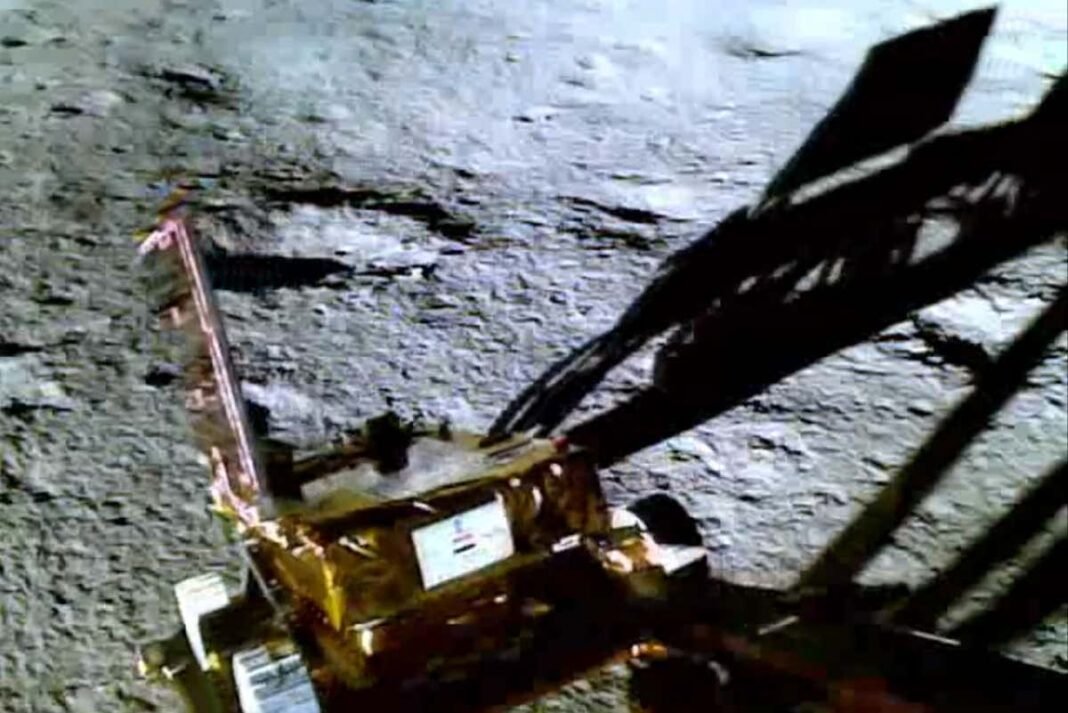The Daily Observer London Desk: Reporter- John Furner
Chandrayaan-3’s Pragyan rover going down a ramp from the lander to reach the surface of the moon
India’s historic Chandrayaan-3 moon mission is now exploring the lunar surface near the south pole. Buoyed by the successful landing, the country is looking to push ahead with putting a human in space and sending a craft to Mars.
Four hours after the Indian Space Research Organisation (ISRO) mission landed on 23 August, and the sun had risen on the landing site, Chandrayaan-3 lowered a ramp and the six-wheeled Pragyan rover, which weighs just 26 kilograms, rolled on to the lunar surface.
Over the next two weeks, the rover will carry out experiments to research the composition of the surface with its Alpha Particle X-Ray Spectrometer and look for water ice, which has the potential to provide a future crewed base with drinking water, oxygen and fuel for spacecraft.
Both the lander and the rover are expected to operate for one lunar day (equivalent to 14 Earth days) before sunset cuts its ability to harvest energy from solar panels. ISRO hasn’t ruled out the possibility that both will be revived once the sun rises after two weeks of darkness and temperatures that will dip to – 238°C (-396.4°F), but this would be a bonus.
India achieved a historic first when it landed the craft near the moon’s south pole. Only China, the US and the Soviet Union had previously softly landed craft anywhere on the moon and no country had explored the south pole.
The mission has been remarkable not only for its firsts, but also for its budget of just Rs 615 crore (£59 million). This is less than half of the inflation-adjusted $149 million budget for the 1995 film Apollo 13 which needed only to depict a mission to the moon.
Chandrayaan-3, which takes its name from the Sanskrit word for “mooncraft”, took off onboard a Launch Vehicle Mark-III rocket from the southern state of Andhra Pradesh on 14 July and spent six weeks covering about 380,000 kilometres en route to the moon.
After a soft landing – which ISRO said in a tweet had taken place 40 days, 3 hours and 29 minutes after launch – Shri M. Sankaran, director of ISRO’s U R Rao Satellite Centre, referenced the preceding Chandrayaan-2 mission, which ended in failure in 2019 when a software glitch caused its Vikram lander to crash into the moon’s surface. It was destroyed, along with the six-wheeled rover it contained, also named Pragyan, that would have explored the moon’s south pole.
“Today, we have achieved what we set out to achieve in 2019,” said Sankaran. “It was delayed by about four years, but we have done it.”
Sankaran went on to say that India would now be looking to push ahead with its space programme and put a human into space and send a craft to Mars. A planned mission to monitor the solar atmosphere from an orbit at the Lagrange point between Earth and the sun, called Aditya-L1, is already due for launch on 2 September.
Chandrayaan-3 Mission:
All planned Rover movements have been verified. The Rover has successfully traversed a distance of about 8 meters.
Rover payloads LIBS and APXS are turned ON.
All payloads on the propulsion module, lander module, and rover are performing nominally.…
— ISRO (@isro) August 25, 2023
The success of Chandrayaan-3 follows a string of failures in moon missions from around the globe. A private attempt by a Japanese start-up in April ended unsuccessfully when it, too, crashed into the surface. Russia’s latest attempt at lunar exploration – its first moon mission in nearly half a century – also ended in disaster earlier this week.
Russia’s Luna 25 lander was due to touch down gently but instead slammed into the surface at speed after what was intended to be a short engine firing to reposition it seemingly continued for too long, causing it to “cease to exist”, the Russian space agency Roscosmos announced.
Dimitrios Stroikos at the London School of Economics and Political Science says that when ISRO first floated the idea of an Indian moon mission it was “a bit difficult to sell it” to a sceptical public, but that things have changed and public support has grown enormously.
“Now it’s more about ‘Great, we did that, we need more of that, what’s next? What about human space flight?’,” says Stroikos. “These sorts of missions are very highly visible and they serve as a normative indicator of a state’s great power, status, modernity and prestige. But it’s a great scientific feat as well. [As] we saw with Luna-25, it’s very difficult to achieve a soft landing.”
The Chandrayaan-3 might well leave a lasting mark on the moon. ISRO didn’t respond to a request for interview, but the tread of Pragyan’s rear wheels are reportedly stamped with the ISRO logo and either the Lion Capital of Ashoka or the Ashoka Chakra and will leave imprints of both on the surface of the moon as it traverses at just 1 centimetre a minute.



